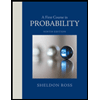
A First Course in Probability (10th Edition)
10th Edition
ISBN: 9780134753119
Author: Sheldon Ross
Publisher: PEARSON
expand_more
expand_more
format_list_bulleted
Question
- Use the transformation technique to find the density
function for the random variable Y. The density function should be given as apiecewise function .
f(x) = 1/3e^-1/3x x>0 Y=e^x
0 elsewhere
Expert Solution
This question has been solved!
Explore an expertly crafted, step-by-step solution for a thorough understanding of key concepts.
This is a popular solution
Trending nowThis is a popular solution!
Step by stepSolved in 2 steps with 2 images

Knowledge Booster
Similar questions
- Example: The Gamma Distribution Suppose X ~ T(a, B), then M(t) = dx BaT(a) 22 Now we do a little high school algebra. Define & = Then one may write 1-Bt" Equation (22) as: M(t) = ()ª / (23) dx One recognizes the integrand of Equation (23) as a r(a, 6) density, hence 8. M(t) = (Gr"(1) = (1 - AY• (24) (1 – Bt)a Exercise 5. Verify the algebra leading from Equation (22) to Equation (23).arrow_forwardThe joint density function for random variables X and Y is f(x, y). Find the conditional mean and variance of X given Y = 1/2 f(x,y) = 12/7(x^2 + xy) 0<x<1, 0<y<1 0 elsewhere = _mean1/2________________ = _var1/2________________arrow_forwardLet X and Y be random variables with joint density function ,0 < x < 4 and 1 < y < 5 f(x,y) = {xy/96 | ,otherwise. } Find the joint density function g(u,v) for the transformed variables U = X + 2Y and V = X. Specify the domain of g and draw the domain.arrow_forward
Recommended textbooks for you
 A First Course in Probability (10th Edition)ProbabilityISBN:9780134753119Author:Sheldon RossPublisher:PEARSON
A First Course in Probability (10th Edition)ProbabilityISBN:9780134753119Author:Sheldon RossPublisher:PEARSON

A First Course in Probability (10th Edition)
Probability
ISBN:9780134753119
Author:Sheldon Ross
Publisher:PEARSON
